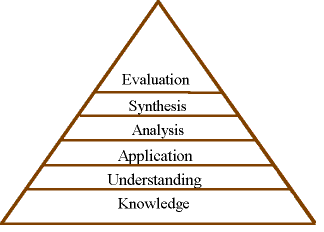Table of Contents
Introduction
Bloom’s Taxonomy is a foundational framework in education that classifies learning objectives into hierarchical levels. First introduced in 1956 by Benjamin Bloom and his colleagues, this taxonomy has since been revised and expanded to better reflect modern educational practices.
It serves as a valuable tool for teachers, curriculum designers, and learners alike, helping to structure and elevate the learning process.
In this post, we’ll explore the three domains of Bloom’s Taxonomy, break down its levels, and discuss its implications for teaching and learning English.
What is Bloom’s Taxonomy?

Bloom’s Taxonomy is a classification system that organizes learning objectives into three domains: cognitive, affective, and psychomotor.
Originally focused on the cognitive domain, the taxonomy has been adapted over time to include the affective and psychomotor domains, making it a holistic framework for education.
The Three Domains of Bloom’s Taxonomy
Bloom’s Taxonomy divides educational objectives into three distinct domains:
- Cognitive Domain: Focuses on intellectual skills and knowledge.
- Affective Domain: Deals with emotions, attitudes, and values.
- Psychomotor Domain: Centers on physical skills and manual tasks.
Let’s explore each domain in detail.
1. The Cognitive Domain
The cognitive domain is the most well-known and widely used part of Bloom’s Taxonomy. It categorizes learning objectives into six levels, progressing from basic recall of facts to higher-order thinking skills like analysis, synthesis, and evaluation.
Here are the six levels of the cognitive domain, along with examples of verbs that align with each level:
- Knowledge: Recall facts, terms, or basic concepts.
Example Verbs: define, list, memorize, recall, state. - Comprehension: Demonstrate understanding of ideas.
Example Verbs: explain, summarize, interpret, classify, describe. - Application: Use knowledge in new situations.
Example Verbs: apply, solve, demonstrate, illustrate, execute. - Analysis: Break down information into parts and examine relationships.
Example Verbs: analyze, compare, contrast, differentiate, examine. - Synthesis: Combine elements to create something new.
Example Verbs: design, create, compose, formulate, propose. - Evaluation: Make judgments based on criteria and standards.
Example Verbs: evaluate, judge, critique, justify, assess.
Practical Application in English Teaching:
- Use the cognitive domain to design lesson plans that progress from basic vocabulary recall (knowledge) to critical analysis of a text (evaluation).
- Create activities like summarizing a story (comprehension), writing an essay (application), or debating a topic (evaluation).
2. The Affective Domain
The affective domain focuses on emotional growth, attitudes, and values. It emphasizes how learners respond to and internalize new information. This domain is particularly important in language learning, as it influences motivation, empathy, and cultural understanding.
The affective domain consists of five levels:
- Receiving: Paying attention to new information.
Example: Listening to a lecture or reading a text. - Responding: Actively participating in the learning process.
Example: Answering questions or participating in a discussion. - Valuing: Recognizing the worth of new information.
Example: Appreciating the cultural context of a story. - Organizing: Integrating new information into existing beliefs.
Example: Reflecting on how a new perspective aligns with personal values. - Characterizing: Internalizing new attitudes or behaviors.
Example: Demonstrating empathy or adopting a growth mindset.
Practical Application in English Teaching:
- Encourage students to engage with emotionally resonant texts or role-playing activities to develop empathy and cultural awareness.
- Use group discussions to help students articulate their values and reflect on diverse perspectives.
3. The Psychomotor Domain
The psychomotor domain focuses on physical skills and manual tasks. While it may seem less relevant to language learning, it plays a role in activities like handwriting, typing, or even acting out scenes in a play.
R.H. Dave’s (1967) classification of the psychomotor domain includes five levels:
- Imitation: Copying an action.
Example: Mimicking a teacher’s pronunciation. - Manipulation: Performing a skill from instructions.
Example: Writing a sentence based on a model. - Precision: Executing a skill accurately.
Example: Delivering a speech with clear pronunciation. - Articulation: Adapting skills to new situations.
Example: Using gestures to enhance communication. - Naturalization: Mastering a skill effortlessly.
Example: Speaking fluently without hesitation.
Practical Application in English Teaching:
- Incorporate role-playing, drama, or public speaking exercises to develop physical and verbal communication skills.
- Use games or interactive activities to reinforce fine motor skills like writing or typing.
Educational Implications of Bloom’s Taxonomy
Bloom’s Taxonomy has far-reaching implications for teaching and learning. Here’s how it can be applied in the classroom:
- Curriculum Design: Teachers can use the taxonomy to structure lessons that progress from basic to advanced skills.
- Assessment: The taxonomy helps create assessments that measure different levels of understanding, from recall to critical thinking.
- Critical Thinking: By focusing on higher-order thinking skills, teachers can foster creativity and problem-solving abilities.
- Student Engagement: The taxonomy encourages active learning by incorporating diverse activities that cater to different domains and levels.
Bloom’s Taxonomy with Examples: Teaching a Language Point
Bloom’s Taxonomy can be a powerful tool for teaching language points like grammar or vocabulary. Here’s how you can apply each level to a lesson on the past simple tense:
- Knowledge:
- Ask students to recall the structure of the past simple tense (e.g., Subject + verb + -ed).
Example: What is the past tense of “walk”?
- Ask students to recall the structure of the past simple tense (e.g., Subject + verb + -ed).
- Comprehension:
- Have students explain when and why the past simple tense is used.
Example: Why do we say “I walked to school” instead of “I walk to school”?
- Have students explain when and why the past simple tense is used.
- Application:
- Ask students to write sentences using the past simple tense in a new context.
Example: Write three sentences about what you did last weekend.
- Ask students to write sentences using the past simple tense in a new context.
- Analysis:
- Have students compare the past simple tense with another tense (e.g., present perfect).
Example: What’s the difference between “I walked” and “I have walked”?
- Have students compare the past simple tense with another tense (e.g., present perfect).
- Synthesis:
- Challenge students to create a short story or dialogue using the past simple tense.
Example: Write a conversation between two friends about their last vacation.
- Challenge students to create a short story or dialogue using the past simple tense.
- Evaluation:
- Ask students to assess the accuracy of sentences using the past simple tense.
Example: Is this sentence correct? “She didn’t went to the party.” Why or why not?
- Ask students to assess the accuracy of sentences using the past simple tense.
This approach ensures students move from basic understanding to higher-order thinking, helping them master the language point in a structured and engaging way.
Another application of Bloom’s Taxonomy to teach a novel is to start with comprehension questions (What happened in the story?), move to analysis (Why did the character make that decision?), and end with evaluation (Do you agree with the character’s actions?).
FAQs About Bloom’s Taxonomy
What is Bloom’s Taxonomy with an example?
Bloom’s Taxonomy is a framework that classifies learning objectives into six levels, from basic recall to higher-order thinking. It helps teachers design lessons that progressively build students’ skills.
Example: When teaching a novel, you might start with comprehension questions (What happened in the story?), move to analysis (Why did the character make that decision?), and end with evaluation (Do you agree with the character’s actions?).
What are the 6 levels of Bloom’s Taxonomy?
The six levels of Bloom’s Taxonomy (cognitive domain) are:
– Knowledge: Recall facts or basic concepts.
– Comprehension: Understand and explain ideas.
– Application: Use knowledge in new situations.
– Analysis: Break down information into parts.
– Synthesis: Combine ideas to create something new.
– Evaluation: Make judgments or critique ideas.
What is the importance of Bloom’s Taxonomy?
Bloom’s Taxonomy is important because:
– It provides a clear structure for designing lessons and assessments.
– It encourages critical thinking and creativity.
– It helps teachers ensure students progress from basic to advanced skills.
– It makes learning more engaging and effective.
How to use Bloom’s Taxonomy?
To use Bloom’s Taxonomy:
– Identify the learning objective.
– Choose activities or questions that align with each level of the taxonomy.
– Start with lower-order thinking (e.g., recall facts) and progress to higher-order thinking (e.g., evaluate or create).
– Use it to design lessons, assessments, and classroom activities.
How do you use Bloom’s Taxonomy in an English lesson plan?
Here’s how to apply Bloom’s Taxonomy in an English lesson about the past perfect:
Here’s how to apply Bloom’s Taxonomy to teach the past perfect tense:
– Knowledge: Ask students to recall the structure of the past perfect tense (Subject + had + past participle).
Example: What is the past perfect form of “eat”?
– Comprehension: Have students explain when and why the past perfect is used (e.g., to describe an action completed before another past action).
Example: Why do we say, “She had left before I arrived”?
– Application: Ask students to write sentences using the past perfect in context.
Example: Write three sentences about what you had done before coming to class today.
– Analysis: Have students compare the past perfect with the past simple tense.
Example: What’s the difference between “I had eaten” and “I ate”?
– Synthesis: Challenge students to create a short story or dialogue using the past perfect tense.
Example: Write a conversation about two events, one happening before the other.
– Evaluation: Ask students to assess the accuracy of sentences using the past perfect tense.
Example: Is this sentence correct? “He had went to the store before dinner.” Why or why not?
Conclusion
Bloom’s Taxonomy is more than just a theoretical framework—it’s a practical tool for enhancing teaching and learning. By understanding and applying its principles, educators can create more effective and engaging lessons that cater to the diverse needs of their students.
Bloom’s Taxonomy provides a roadmap for fostering deeper understanding and critical thinking.
References
- Bloom, B. S. (1956). Taxonomy of Educational Objectives: The Classification of Educational Goals. Susan Fauer Company, Inc.
- Anderson, L. W., Krathwohl, D. R., & Bloom, B. S. (2001). A Taxonomy for Learning, Teaching, and Assessing: A Revision of Bloom’s Taxonomy of Educational Objectives. Addison Wesley Longman, Inc.
- Krathwohl, D. R., Bloom, B. S., & Masia, B. B. (1964). Taxonomy of Educational Objectives. Handbook II: The Affective Domain.
- Romiszowski, A. (1999). The Development of Physical Skills: Instruction in the Psychomotor Domain. In C. M. Reigeluth (Ed.), Instructional Design Theories and Models: A New Paradigm of Instructional Theory (Volume II). Lawrence Erlbaum Associates.


